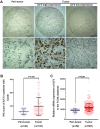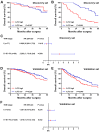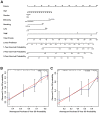High expression of interleukin-enhancer binding factor 3 predicts poor prognosis in patients with lung adenocarcinoma
- PMID: 32194712
- PMCID: PMC7039148
- DOI: 10.3892/ol.2020.11330
High expression of interleukin-enhancer binding factor 3 predicts poor prognosis in patients with lung adenocarcinoma
Abstract
Interleukin-enhancer binding factor 3 (ILF3) is a double-stranded RNA-binding protein that has been reported to contribute to the occurrence and progression of various malignant tumors. The aim of the present study was to evaluate the prognostic value of ILF3 and to apply this knowledge to avoid excessive medical treatment in patients with lung adenocarcinoma (LUAD). ILF3 expression in a discovery set consisting of tumor and peri-tumor tissue microarrays was analyzed using immunohistochemical methods. The mRNA level of ILF3 was subsequently analyzed in a validation set downloaded from The Cancer Genome Atlas. The Kaplan-Meier method, univariate and multivariate Cox analyses, decision curve analysis and nomogram models were used to evaluate the prognostic value of ILF3. ILF3 expression was upregulated in tumor tissues compared with peri-tumor tissues and was negatively associated with the overall survival time of patients with LUAD in the discovery and validation sets. Moreover, ILF3 expression was used for risk stratification in patients with tumor-node-metastasis stages II-IV and poor-to-moderate tumor differentiation. ILF3 expression was identified as an independent predictor of adverse prognosis for patients with LUAD in the discovery and validation sets. Finally, nomogram models for the 3- and 5 year survival time of patients with LUAD revealed that ILF3 expression may be used to improve the predictive accuracy of the prognosis and to avoid excessive medical treatment for certain patients with the disease. Overall, the data obtained in the current study revealed that high ILF3 expression was associated with poor prognosis, and demonstrated that ILF3, as a potential independent risk factor, may improve the hierarchical postoperative management of patients with LUAD.
Keywords: interleukin-enhancer binding factor 3; lung adenocarcinoma; overall survival; prognosis; risk factor.
Copyright: © Xu et al.
Figures







References
LinkOut - more resources
Full Text Sources
Miscellaneous
